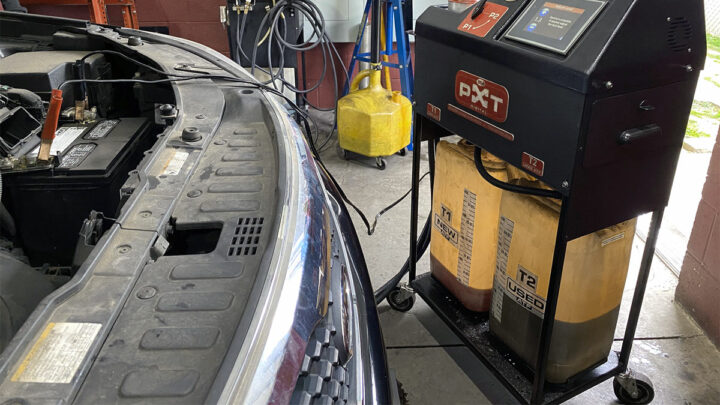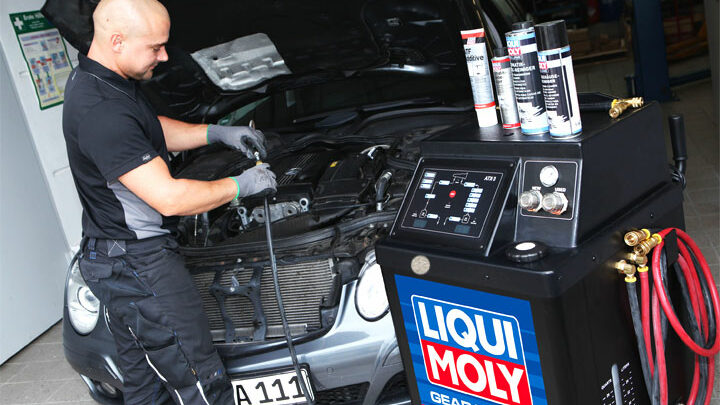Is a Transmission Flush Really Necessary? (Here’s the Truth)
The matter of whether or not a transmission flush is truly necessary is quite controversial, and lately a matter open for debate. This being said, most car manufacturers and industry professionals are now in agreement that a transmission flush is not a necessary service, despite it being touted as sound practice in years past.
There are many misgivings surrounding transmission flush procedures, including their purpose, benefits/risks, and value. The following is intended to clear the air, by giving consumers the necessary information to make an informed decision regarding whether or not a transmission flush is a service worth paying for.
First, let’s get to the bottom of what a transmission flush is, and isn’t.

What Is a Transmission Flush?
A transmission flush is a service that exchanges all old automatic transmission fluid (ATF), with new, fresh ATF. This fluid is exchanged under pressure, and is intended to remove deposits and other contaminants from your vehicle’s transmission.
In theory, all old transmission fluid will be removed during a flush, including that within the transmission’s torque converter.
Services of this type are generally completed at dealerships or quick-service establishments, with the use of a specialized machine. These services typically take 30-45 minutes and cost approximately $125-$250 to complete. Many service centers claim that a vehicle requires a transmission flush every 30,000-60,000 miles.
Theory vs Reality

While it is indeed true that virtually every automotive manufacturer specifies the need for periodic transmission “service”, the specifics of such service are often left to interpretation.
For years, the standard protocol has called for the draining and refilling of a vehicle’s transmission fluid, as well as the application of a new transmission filter. However, somewhere along the way, the practice of transmission flushing gained popularity.
Proponents of the transmission flush claim that a service of the like is required to remove all old transmission fluid in its entirety, making a standard drain/fill service inadequate. If this were true, then shouldn’t all engine oil be purged under pressure in a similar manner, to eliminate any remaining used motor oil?
The truth is, the idea of routine maintenance as a whole, is likely far more important than the chosen manner in which aging transmission fluid is discarded. While you can’t argue against the notion that a standard drain/fill service leaves some degree of used ATF behind, it’s reasonable to assume that these amounts are relatively nominal.
When transmission fluid is changed at regular intervals, little in the way of sludge or contamination is allowed to build, thereby negating many of the arguments surrounding the necessity of a transmission flush.
Simply put, the real benefit comes from regularly servicing your transmission, regardless of whether you choose a standard fluid change or a flush. Performing transmission maintenance at consistent intervals is what truly matters.
Related: Transmission Fluid Color Chart
Why, Then, Are Transmission Flush Services Offered?

There are many automotive services that have gained popularity throughout the years, due in large part to their ability to generate money. In many ways, transmission flush procedures fall into this category.
While most vehicle owners can easily drain and fill their own transmission fluid at home, as specified by most manufacturers, very few possess the ability to perform a “flush” based service.
This, in turn, is why most quick-service establishments push to upsell transmission flush services. While oil changes and tire rotations keep the lights on at such shops, upsell services with plenty of financial upsides achieve profits.
In many ways, this is no different than purchasing an electronic device through a retailer, only to be offered 3-4 elaborate extended warranty plans at checkout, all in the name of protection.
Transmission Flush: Potential Harm

To this point, there has been an emphasis placed on choosing between transmission flush services and standard transmission services, based largely on preference, rather than a perceived need. However, there are circumstances under which a transmission flush is absolutely not recommended.
The most pertinent of which is when dealing with a high-mileage vehicle that has received no transmission service in its lifetime.
If a vehicle has reached high mileage without its transmission being serviced, there is a rather good chance of the transmission’s ATF containing a significant amount of clutch media. In the most severe of cases, the presence of this clutch media laden fluid is often serving to assist with the engagement of otherwise worn-out clutches.
Under such circumstances, a transmission flush should be avoided, in a bid to prevent further slippage.
Read Also: Symptoms of a Burnt Transmission Fluid
The Verdict
The long and short of the matter is that a vehicle does not require a “transmission flush” unless specified by its manufacturer. Rather, periodic transmission services, wherein both fluid and filter are changed, are typically more than enough to sustain the life of a vehicle’s transmission.
Moreover, choosing to have a transmission flush conducted late in a vehicle’s life, following years of no meaningful maintenance, is of little value and is likely to do more harm than good.
After enough time without periodic transmission maintenance, the damage itself has already been done. Flushing a transmission under pressure is likely to expel any free-floating clutch material that might be helping to prevent slippage.
At the end of the day, a transmission flush should be looked at simply as a service that can be conducted in place of a standard drain/fill service. If this is the maintenance route that one wishes to take, they should continue this regimen throughout the life of their vehicle, whenever transmission service is specified per their vehicle’s manufacturer.
Even under these circumstances, choosing periodic transmission flushes over transmission drain/fill services is only likely to have minimal effects, in terms of extending a transmission’s longevity. At the end of the day, a transmission is still a mechanical component, and is prone to eventual failure, no matter how well it is taken care of.
Pros & Cons of Transmission Flush Services

Ultimately, without manufacturer specification, the decision to flush a transmission comes down to personal preference. Below are lists weighing the pros and cons of transmission flushes to help you determine if it’s the right service for you and your vehicle.
Pros
- Completely eliminates old ATF from transmission/torque converter
- Can be done rather quickly by trained technicians
- Eliminates the need to remove drain plugs or drop the transmission pan
Cons
- Typically quite costly to have performed
- Requires a trip to an authorized service center
- Is only slightly more effective at keeping transmission free of deposits and contamination than the standard drain/fill procedure.
- P0480 Code (Symptoms, Causes, and How to Fix) - Apr 19, 2024
- Car Temperature Gauge Stopped Working? (Here’s Why) - Apr 15, 2024
- Ignition Coil vs Coil Pack (What’s the Difference?) - Apr 8, 2024
